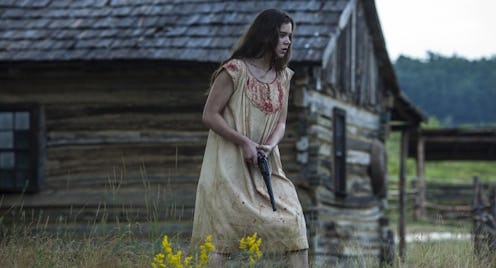Entertainment
'The Keeping Room' Gets Women's War Stories Told

In The Keeping Room, a new Civil War-set film starring Brit Marling, Muna Otaru, and Hailee Steinfeld, the three female characters are left alone on the family plantation, surrounded by the wasteland of the war-era South. With no one else around, they band together against the threat of two Union soldiers out front of the rapidly approaching Northern army. It's the type of bold, female-centric story rare for Hollywood — and according to Keeping Room screenwriter Julia Hart, it's part of an effort to reclaim the female narrative.
“At the moment, we have most of our stories and most of our characters being created by men,” Hart tells Bustle. But "both genders have an interesting perspective to bring to their own gender and to the other gender."
In fact, a 2014 study released by the Center for the Study of Women in Television and Film found that women made up just 11 percent of screenwriters on the top 250 grossing movies that year — and 35 percent of those top films employed one or zero women. In other words, movies like The Keeping Room are a rarity. The film (out Sept. 25) isn't just unique for its behind-the-scenes production, though. It begins with a myth — a story of unmarked Union graves at a Civil War-era plantation home — and the movie in turn constructs its own mythology, based around gender.
“There’s so much that’s documented about the male experience in our history, and particularly the white male experience in our history, so I think what we have to do a bit as women is mythologize and tell stories,” Hart says.
Because there are so few sources available about the female experience during the war, Hart imagined a story with a “period quality” rather than a historically accurate narrative. “The women come across as progressive both in terms of the way they’re thinking and the way they’re interacting with each other,” she says — adding, “At least, I hope."
The three leads at the heart of the film earn their strength both physically and mentally, blending traditional signifiers of masculinity and femininity. Augusta, played by Marling, “has been thrust into the role of father and classic patriarch,” Hart says, while Louise, Steinfeld’s character, “comes to her strength the latest” — she’s forced to grow up a little bit and then all at once when the plantation comes under siege. And Mad, played by Otaru, was once the family’s slave, though the master-slave dichotomy has been all but abandoned by the time the camera settles on these three women. “She comes with an inner balance and strength,” Hart says.
In one particularly chilling scene, Hart plays on the audience’s likely assumptions about race relations during this period. Augusta and Mad rush to help Louise, who has been bitten by a feral creature just inside the boundaries of the woods surrounding their home. Augusta slaps Mad across the face for a perceived insubordination, and they both pause for a moment. Mad looks up and returns the slap, and the three stand in shock for a brief moment. You’re just waiting for something catastrophic. But Augusta finally breaks the silence, urging both herself and Mad to return to Louise’s aid. They embrace each other as friends and equals — perhaps not necessarily true to the period, but true to the characters Hart has engendered.
Though The Keeping Room doesn’t moralize, this idea of the female narrative has penetrated the flurry of press around the film, sometimes to the exclusion of all else. “It’s a loud world out there,” Hart says. “If that’s the message that’s getting through, I couldn’t be happier.”
Hart wrote the movie's screenplay five years ago, so its timeline (at least in the film industry, where movies can not infrequently take decades to go from idea to reality) has been a pretty brief one. She just wrapped her second film and first directorial effort, the dramedy Miss Stevens , where she actively sought out female members of the crew to tell the story of a high school teacher whose field trip to a drama competition takes an unexpected turn. After that, she will write an Anna Paquin-produced miniseries for HBO.
“We need more women on both sides of the camera,” Hart says.
Hart, who made her feature-length debut as a screenwriter with The Keeping Room, adds that it’s not enough that women write about their own experiences — there should be more women writing in general, about whatever characters they want to see. Some male writers have created multi-faceted, “absolutely beautiful, strong, incredible” women, and there's a need, she explains, for more for female filmmakers to do the same.
“It’s exciting to see women... are getting to create and control the content that they are participating in and are putting into the world," she says.
Including Hart. Although The Keeping Room is the former English teacher's first film, her father Jim (Contact, August Rush, Hook) and brother Jake are both screenwriters, and her husband is a film producer. (Hart credits him for getting her “sucked back into the family business.”) Due to her family's inclinations, she says that she was weaned on cinema from the ’20s and ’30s, things like old musicals and John Ford movies, from an early age.
“I look back, and I’m like, why was I watching The Godfather at six?” she recalls. Classic influences are evident in The Keeping Room. It combines elements of siege film, period Western, and gritty horror, but with a twist not often seen in those genres — the three main characters are all women, and for once, getting to tell their stories, their way.
Images: Drafthouse (2)